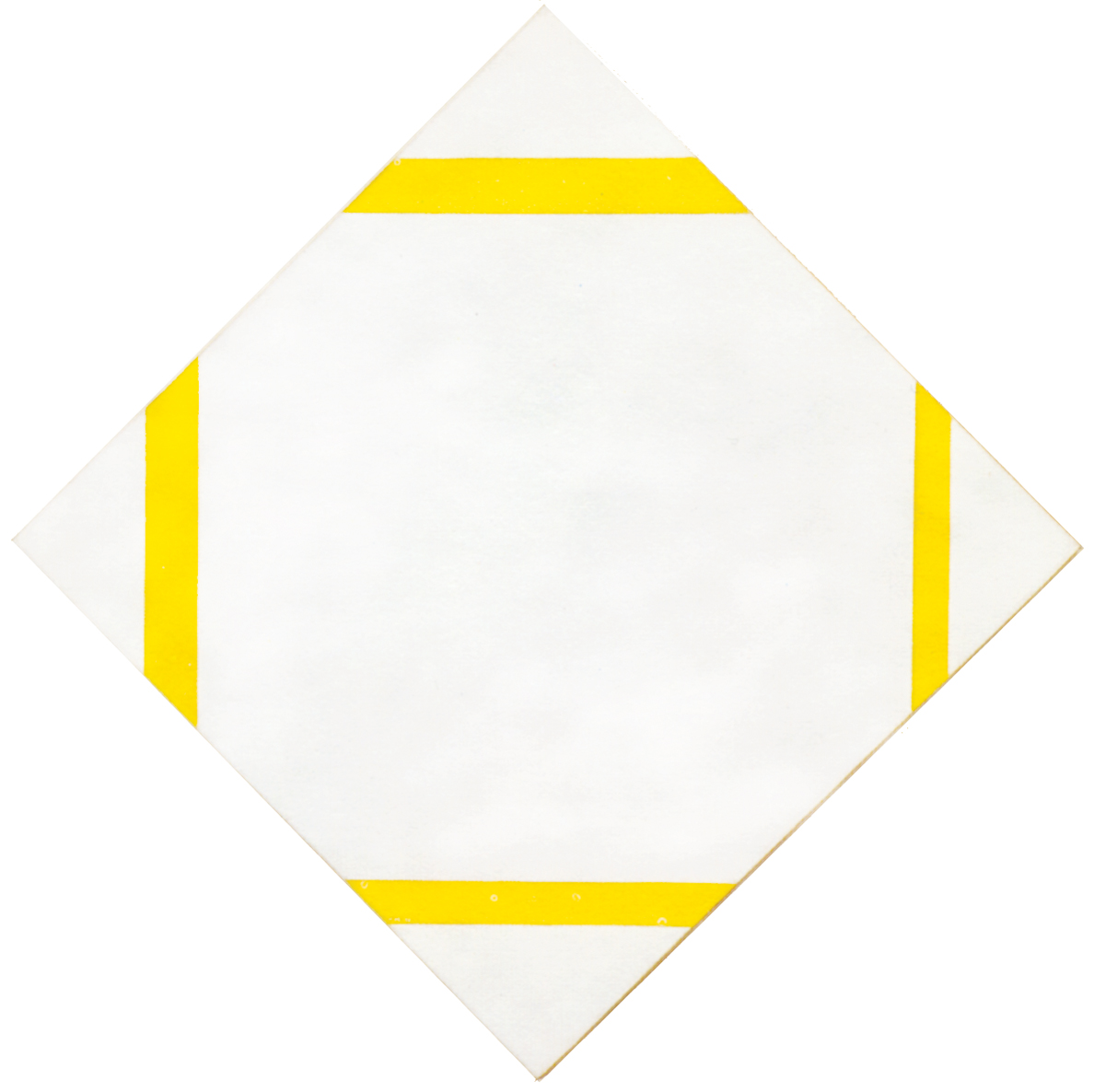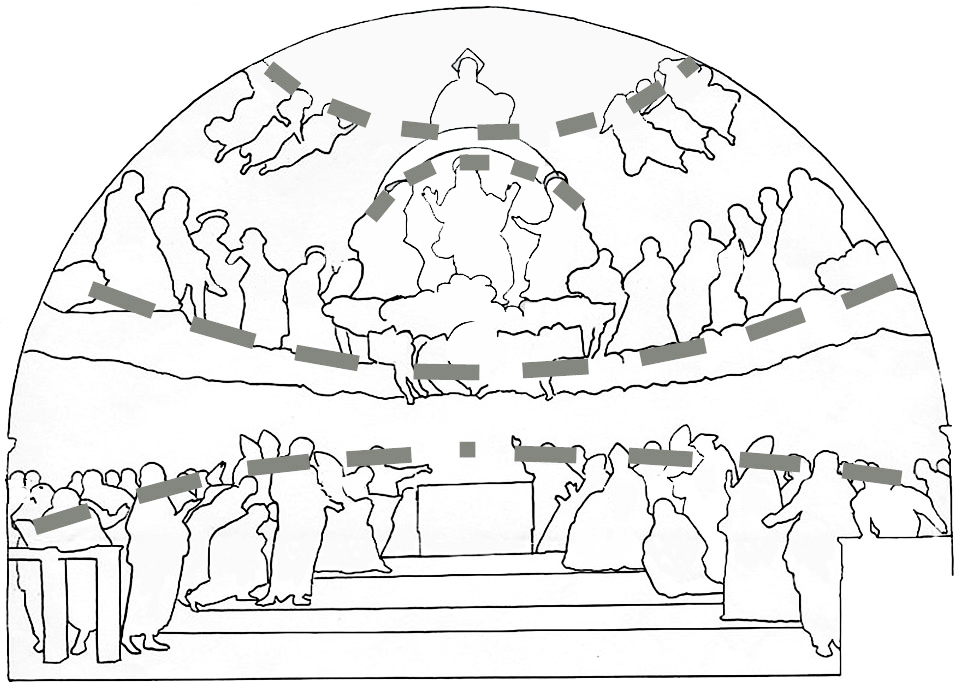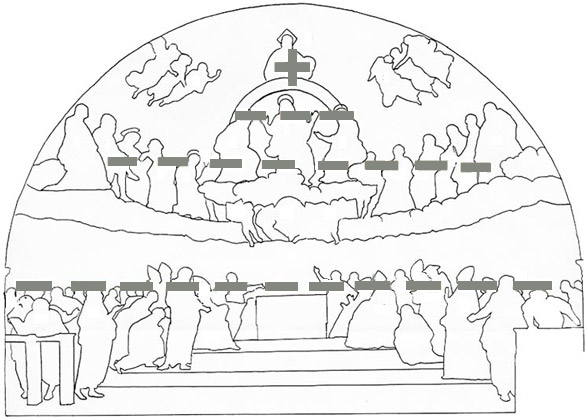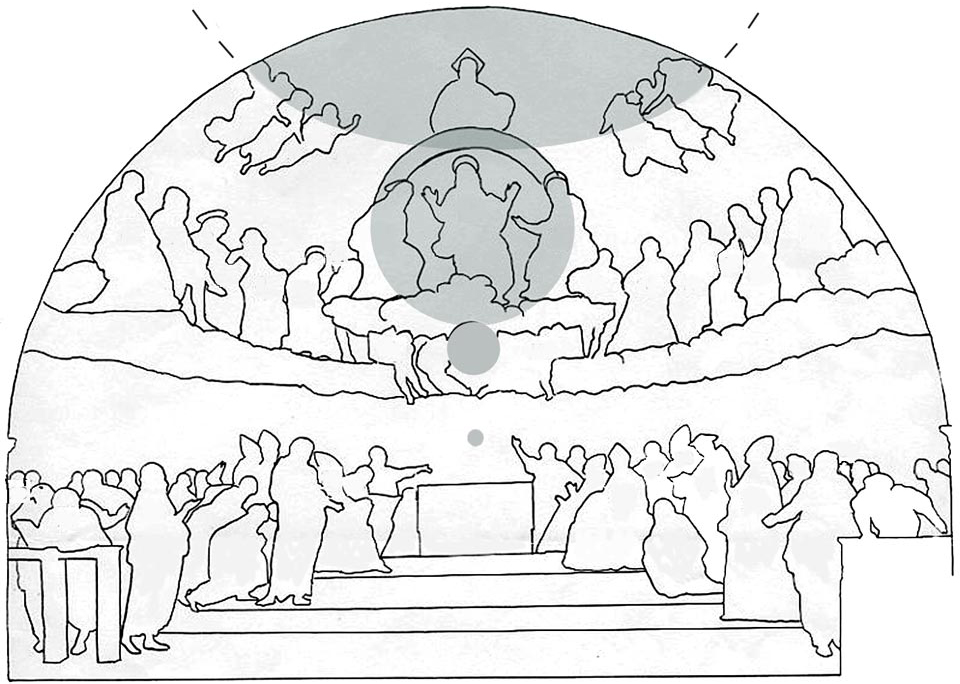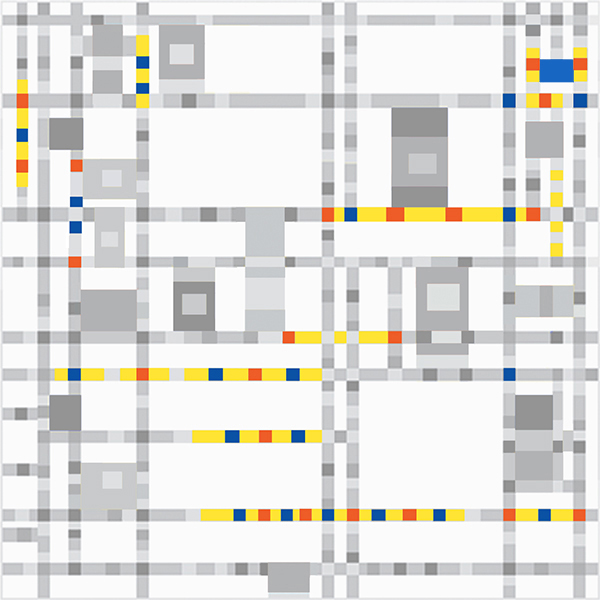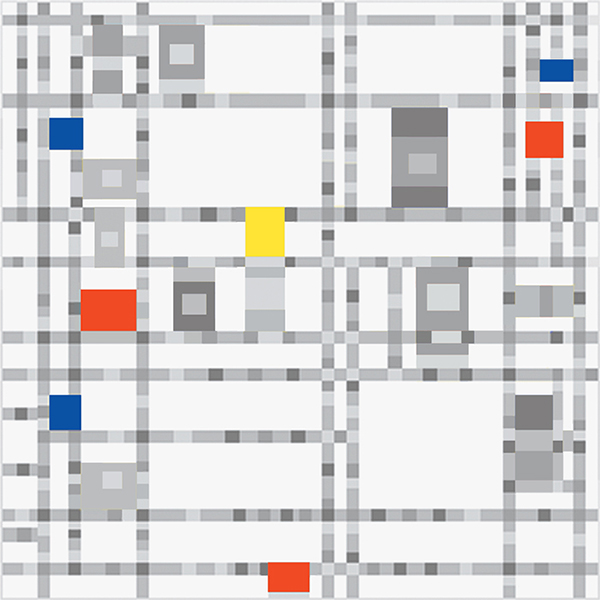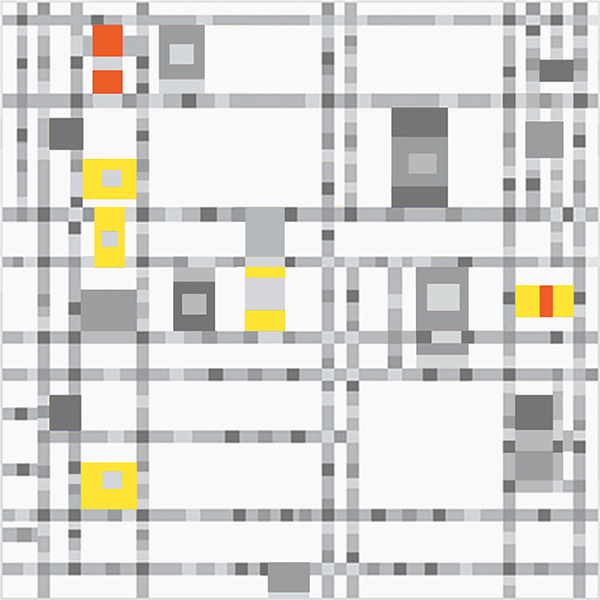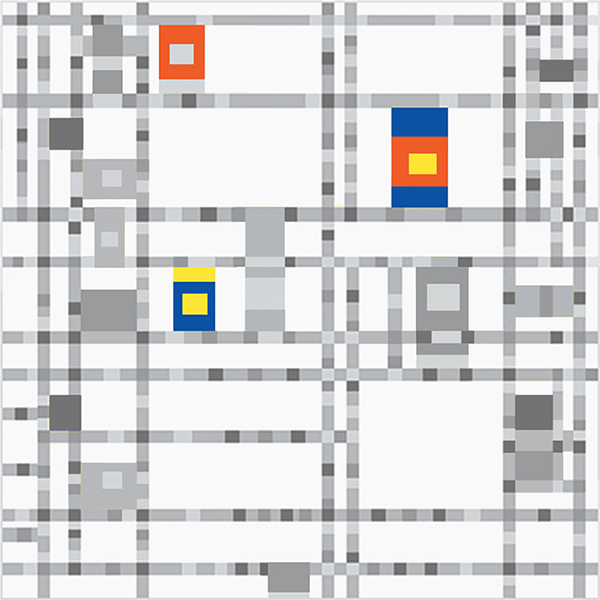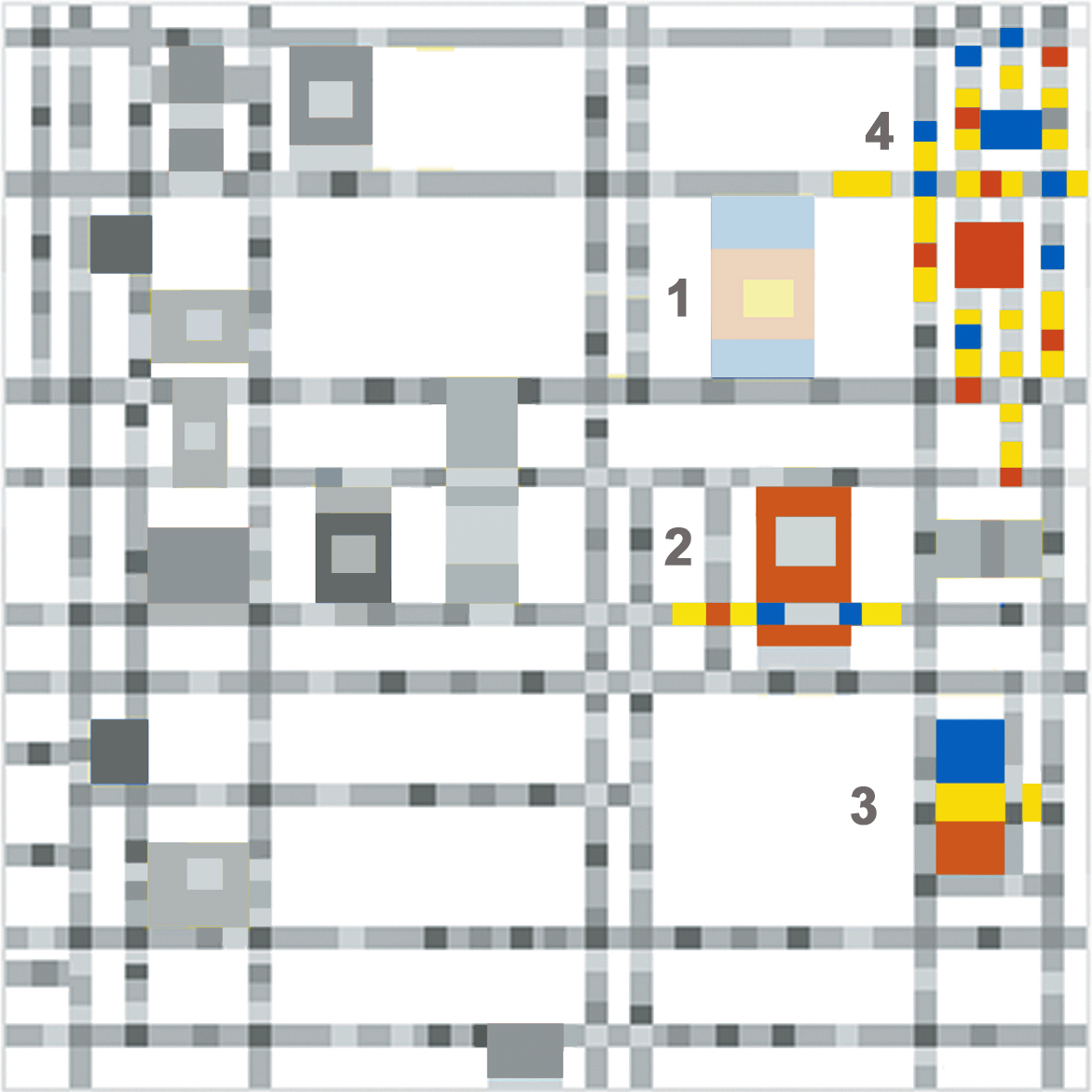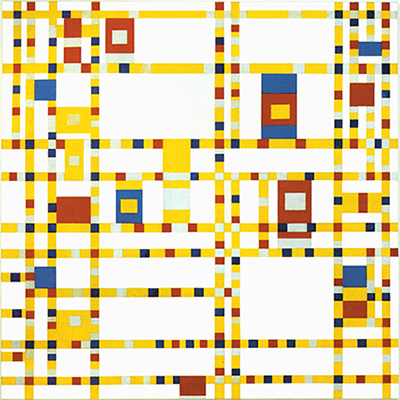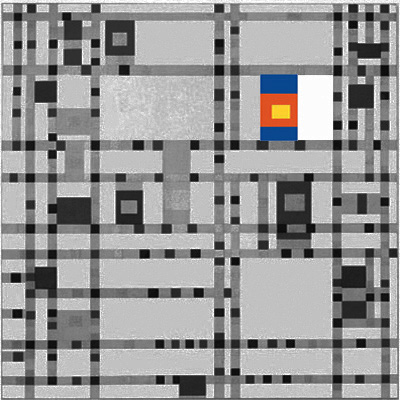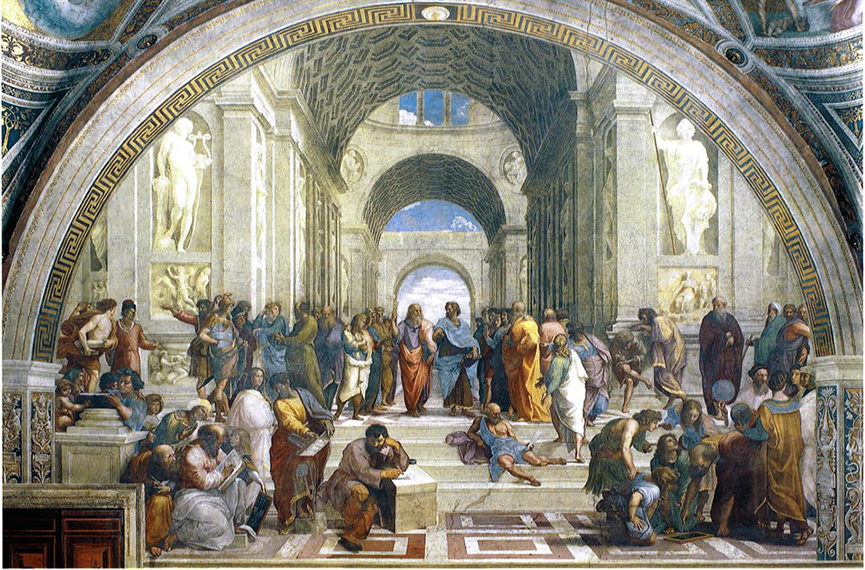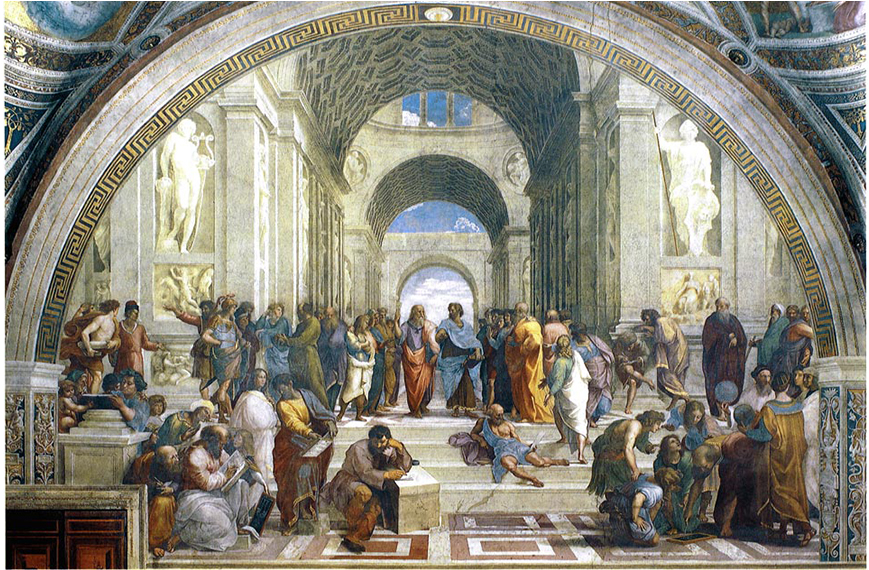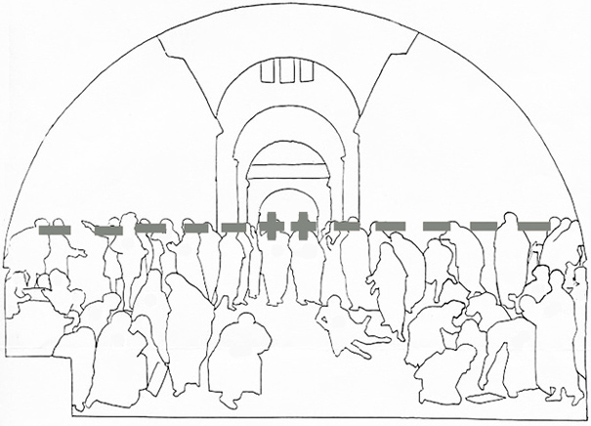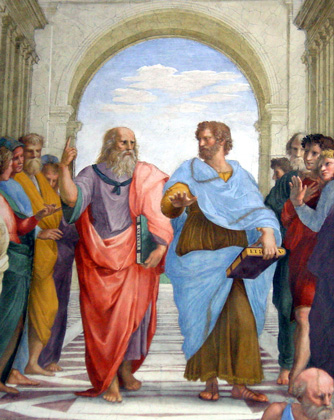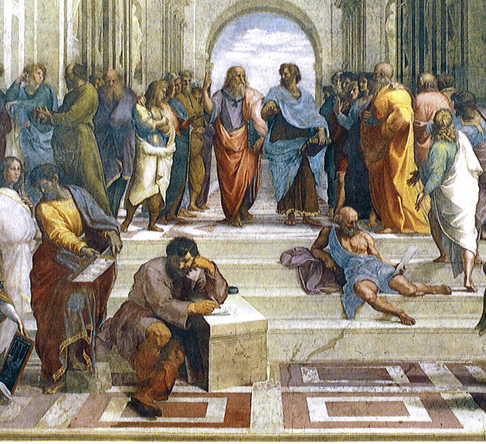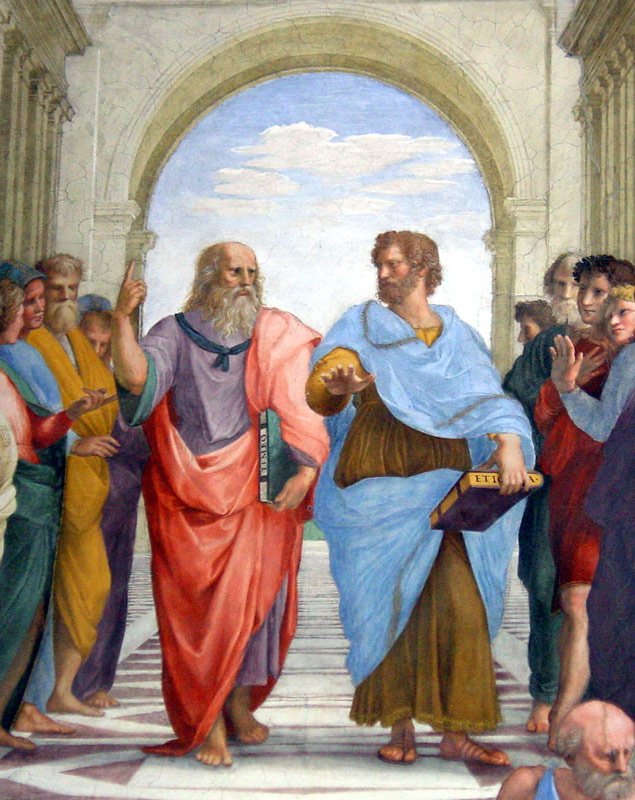Is there continuity between past and present forms of art? At first glance there does not seem to be anything in common between two frescoes that Raffaello Sanzio painted in the Stanza della Segnatura in the Vatican during the early sixteenth century and the last accomplished painting by Mondrian. However, a more careful analysis reveals some interesting affinities between these works.
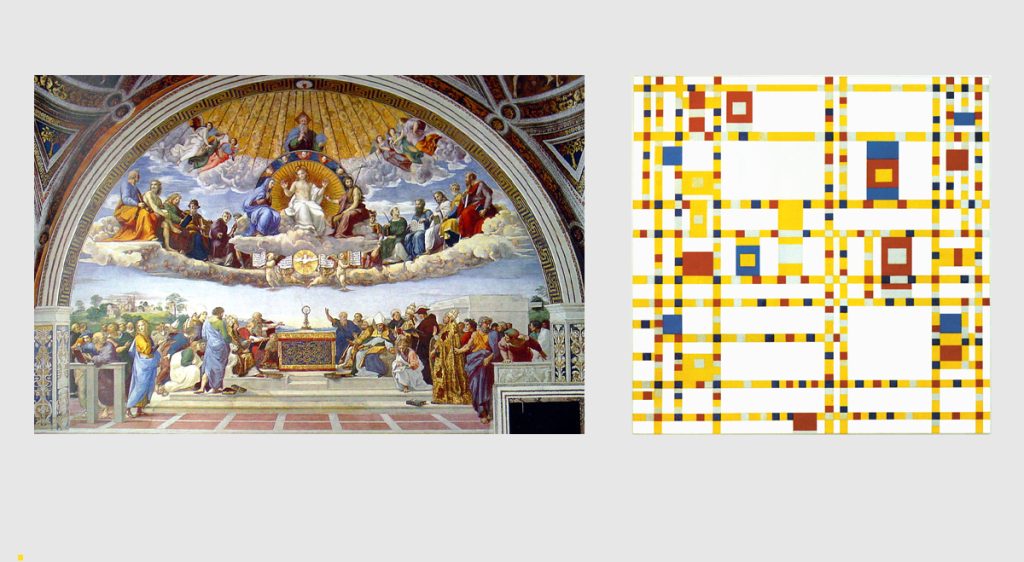
The comparison highlights themes of universal character that are common to the three artworks and shows how, mutatis mutandis, the twentieth-century painting could suggest an ideal synthesis of the two ancient frescoes.
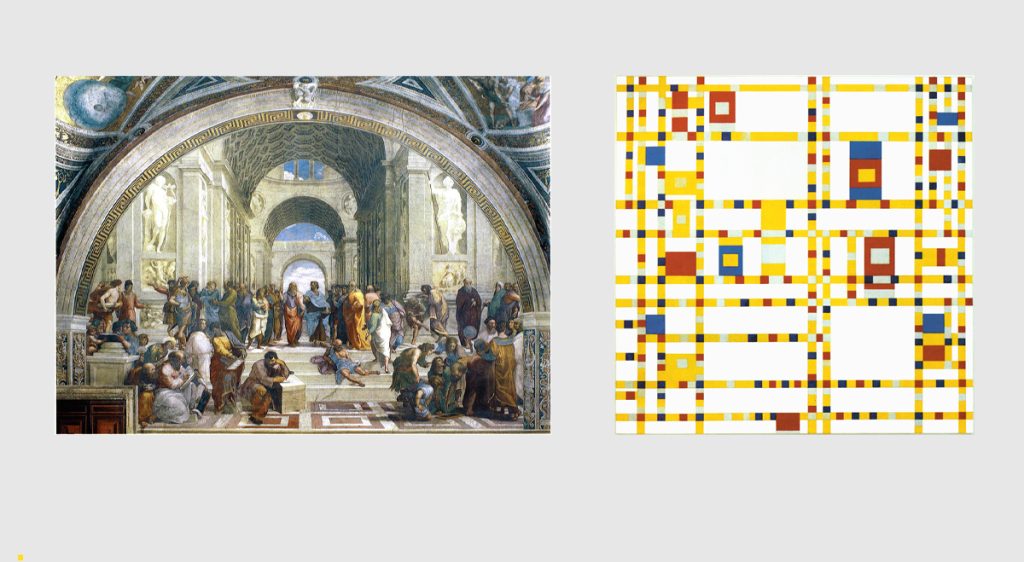
La Disputa del Sacramento and Broadway Boogie Woogie
“The purpose of art is to make visible the invisible.” (Paul Klee)
“Art must express the universal.” (Piet Mondrian)
“What you seek to express is above all unity.” (Henri Matisse)
It seems that present day art disregards these masters convictions. What is often called art today, pursues fragments of reality and no longer seems able to give us a broader and deeper vision of things.
Michel Seuphor, Mondrian’s friend and collaborator in Paris – also an artist, poet and art theorist – described the Dutch master’s work as follows:
“For the first time in history, one of these prophets is an artist, a painter. For the first time, the presence of another world in this world has been entrusted to an image-maker. This time it is not a matter of reading or interpreting, but of seeing. For those who know how to see, I believe that he has succeeded in placing the mystery in full light.”
The sacred
At a first glance we would certainly all agree in attributing a sacred value to Raffaello’s fresco, but we would be suspicious if we said that the same could be said of Mondrian’s painting. We would have no doubts about the sacred character of the ancient painting because in it we recognize obvious symbols of Christianity such as an altar with the host, a dove symbolizing the Holy Spirit, angels with the four Gospels, the figure of Christ and a character above all, immersed in a golden sky, which suggests the Eternal Father. In the modern painting, on the other hand, we see perpendicular lines marked by a succession of small squares and interspersed with larger areas of color:
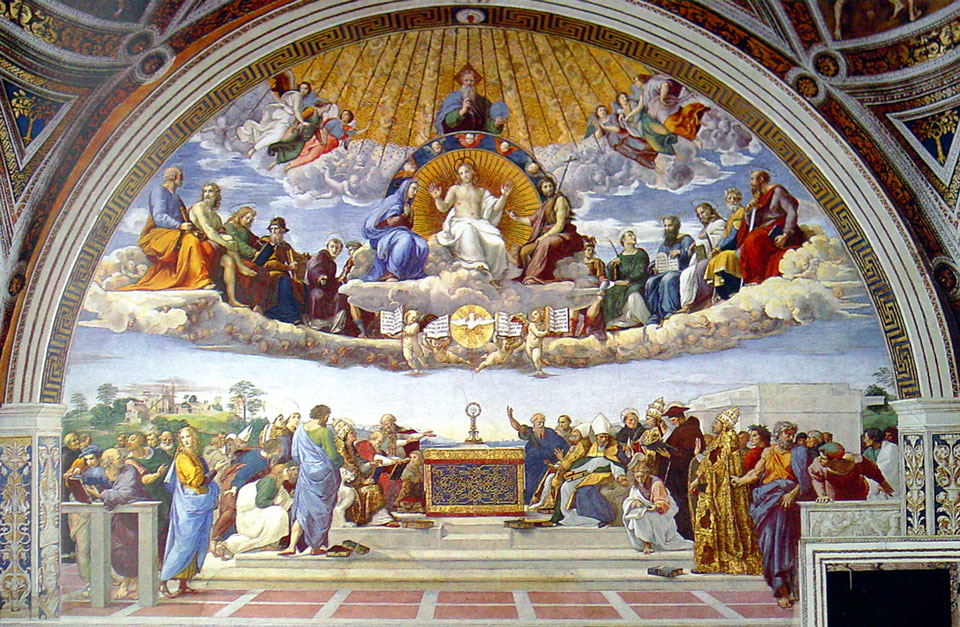
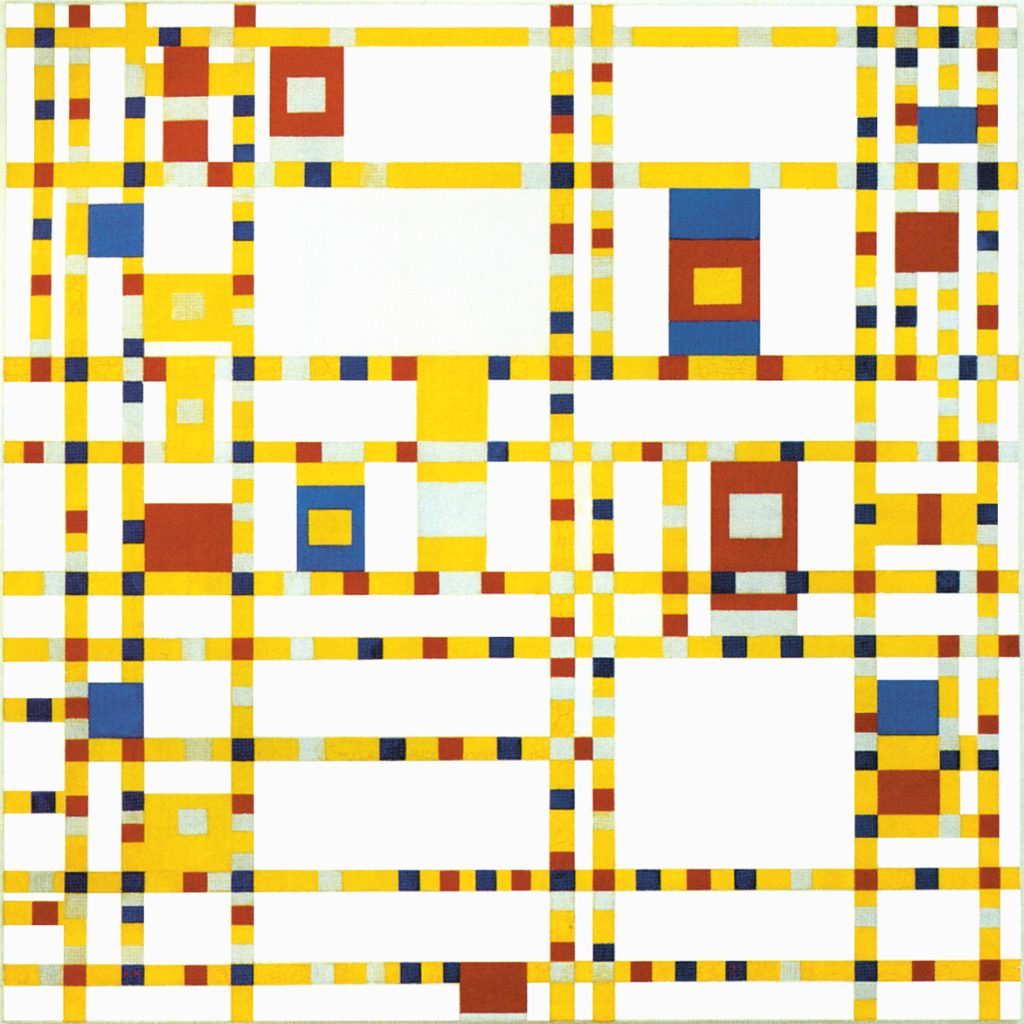
Interesting affinities
What could be sacred in an image without popes, saints and angels flying in the sky? At a distance of four centuries, these two very different works speak to us of substantial aspects of human existence. They certainly do so in a very different way because in the meantime everything has changed in the lives of human beings. Everything has changed, but certain fundamental traits of human nature have not changed that much.
Unity of all things
La Disputa del Sacramento, which is also called Trionfo della Chiesa, is one of three wall frescoes that were commissioned by Pope Julius II Della Rovere to decorate the Stanza della Segnatura in the Vatican palaces. The room has this name because the most important documents of the administrative and political life of the Papal State were usually signed there. La Disputa del Sacramento illustrates the theme of theology.
Opposing forces
The fresco is inscribed in a semicircular wall. Raffaello starts from this pre-existing datum and develops the composition according to a rhythm of concave curved lines that contrast with convex curved lines (Diagram A). Like Mondrian, Raffaello was well aware that a painted surface acquires vital energy from the juxtaposition and encounter of opposing forces. This contrast generates compositional tensions that contribute to the vitality of the represented scene.
Earthly and heavenly worlds
In the lower part of the fresco we see a group of figures who seem to burst onto the scene and distribute themselves animatedly around an altar. Presumably, they are discussing theological issues and each seems to have a certain idea to make their point. In that group, one can recognize some characters of the time including Beato Angelico, Bramante, Francesco Maria della Rovere, Pope Giulio II, and Girolamo Savonarola.
The middle zone depicts an imaginary or metaphysical space where saints and prophets of Christian history are seated in the sky, that is, an intermediary between men and divinity. We note, among others, St. Peter, St. John the Evangelist, Abraham, St. Paul.
From earth to heaven
Earthly randomly assembled figures become higher up an ordered group of twelve figures that are more significant for the Church (saints and prophets); the twelve figures are synthesized towards the center in the three most emblematic figures (the Madonna, Christ and St. John the Baptist) and finally reach unity at the highest point with the figure of God. From a disjointed group of earthly figures we pass to a more uniform semicircular motion (saints and prophets) from which a more stable semicircle is generated (Christ) that finally becomes a sphere in the hand of God (Diagram B).
In this way the painter evokes a progression from the bottom to the top: from an open space that on the ground spreads out horizontally to a space that, developing vertically, concentrates in synthesis, evoking unity. From multiplicity to the one. If the earthly is expressed through a space that extends horizontally and the divine is achieved through a vertical concentration, it is worth remembering that Mondrian also saw in the vertical a symbol of the spiritual.
We will now see how, in addition to this motion that proceeds from the bottom to the top, i.e. from multiplicity to unity, the composition presents a simultaneous progression that descends from the top to the bottom.
The gilded canopy at the top of the fresco evokes a large circular space that ideally extends beyond the painted surface upward.
Descending, that portion of the circle becomes a circle (with Christ) which then transforms into the circle with the dove (symbol of the Holy Spirit) which finally concentrates in the small circle of the monstrance placed on the altar:
From an immense circle that is only partially visible (symbol of the totality in which the figure of God is inscribed), the space proceeds downwards, concentrating on the monstrance.
The reading of the four roundels in a single sequence seems plausible due to the fact that they are all painted in gold.
The fresco thus shows a progression from the multiple toward the one (from the bottom to the top) and a descent of the one toward the multiple. To express this, Raffaello uses contrasting circular tensions that open, close and open again.
From the largest at the top to the smallest at the bottom, the golden energy is concentrated in the monstrance above the altar, the earthly symbol of the kingdom of God
From earth to heaven and from heaven to earth
We thus observe two opposing motions: on one hand we see a motion of elevation of the contradictory figures scattered on the ground towards a more orderly semicircle (saints and prophets) that then becomes a quasi-circle (Christ) and finally a sphere (in the hand of God) and on the other we see a motion of descent from a totality, suggested by the golden cap at the top, towards the quasi-circle with Jesus (God who becomes man) that then becomes a complete circle (the Holy Spirit) to finally concentrate in the small circle of the monstrance.
One contemplates a progression from earth to heaven and a descent from heaven to earth. With great mastery in the art of composition, Raffaello evokes in this way the meeting of men with the divinity.
Also in Mondrian’s work we observe a process that from a manifold condition comes to unity and from unity then reopens to the manifold.
In Broadway Boogie Woogie a duality expressed by horizontal lines opposed to vertical lines generates a multiplicity of small fragments randomly moving along the lines which join up with others here and there to generate symmetrical configurations (Broadway Boogie Woogie Diagram A):
Diagram A: In the top right-hand corner two short vertical symmetries with a red center establish a horizontal correspondence.
Through the act of contemplating a horizontal relationship between two vertical symmetries, we actually generate a field of greater extension, i.e. a plane. In that very point, we see the birth of a small blue plane followed by other planes shown in diagram B where the relationship between horizontal and vertical appears more stable and durable than in the initial fragments moving along the lines:
New planes are born, as shown by diagram C, that differ from those observed in diagram B by presenting an inner space marked with a different color.
Diagram D shows how the self-internalization of space continues and the three primary colors concentrate in the area of just two planes while to the right one plane finally unites yellow, red and blue:
The manifold space made of yellow, red and blue fragments expanding on lines toward opposite directions which disrupted our visual field at the beginning of the process, attain now a unitary synthesis (Diagram E).
The controversial and virtually infinite space of the lines is transformed into a finite and lasting space with the unitary plane. It would, however, be a mistake to see this as calm in the sense of a total absence of inner tension. The unitary plane should rather be seen as a temporary synthesis which reopens to the manifold space around as we shall see in diagram F:
Diagram F: Plane 2 is the same size as plane 1 but consists solely of red and gray rather than the three primary colors. Moreover the horizontal line running suddenly through the vertical plane tends visually to disrupt the previously attained balanced interpenetration of horizontal and vertical (1). After the degree of comparative calm, constancy, and unity achieved in plane 1, spatial movement thus seems to reappear in plane 2. Unity opens up to external space (the horizontal line crossing the plane), the colors are separated and flow back toward the more dynamic and variable space around (3 and 4).
Diagram F: The indication provided by plane 2 finds further confirmation in plane 3, where blue, yellow, and red are juxtaposed but no longer interpenetrate as they did in plane 1. The juxtaposition produces the impression of three separate planes, whereas the interpenetration combines the three colors in a single structure of greater stability. Note how the yellow on the right of plane 3 already seeks to cross the perimeter of the plane and flow into the yellow of the surrounding lines. Plane 3 can therefore be seen as plane 1 in the process of dissolution (4).
Diagrams E and F: Space proceeds from an initial fragmented space towards unity (1) before opening up to the more dynamic and variable external space of the lines (2, 3, 4). Broadway Boogie Woogie shows a process where multiplicity turns into unity which then reopens to multiplicity.
A detailed analysis of the painting here
In a completely different way we see both in the 16th century fresco and in the modern painting a progression from the multiple towards the one and an opposite motion from the one towards the multiple.
Physical and metaphysical
In the ancient fresco, a scene made up of a variety of real people is juxtaposed to a metaphysical scene. We are presented with a real physical horizontal space and an imaginary vertical progression which reaches a divine unity:
Also in Broadway Boogie Woogie the unity comes from an interaction between horizontal and vertical but everything remains at the very same level. There is no dichotomy in the modern painting: physical and metaphysical, multiplicity and unity, everyday and eternal are different aspect of a same nature.
The one descending from above and unity arising inwardly
The ancient fresco evokes a spiritual dimension that governs consciousness from above:
From the manifold set of little squares to the unitary synthesis, the modern painting shows a progressive internalization of space and this urges us to think of the One not as an external entity, fixed a priori and once and for all, but as a dialectic path between opposite drives through which it is possible to reach a certain balance with the inner and outside worlds. Since it is expressed in abstract form, the synthesis evoked in the modern painting suggests in abstract terms a supposed unity of all existing things but also, simultaneously, the unity of the individual consciousness with respect to external reality.
A dynamic unity
For Mondrian, unity is not a truth revealed once and for all in some heavenly place of which some men proclaim themselves interpreters, but rather the result of a constant search within. Paradise is not a privileged place to be reached permanently in a second life but a condition of dynamic equilibrium that begins here and now.
Many times during an existence one can reach paradise and many times one can find him/herself in hell; what Mondrian called the tragic; when there is an imbalance between opposites and duality (diabolus) (from the Greek dia = through and ballo = to put in the middle, to separate) lacerates the integrity of consciousness and unity flows back into a contradictory multiplicity. Just what Broadway Boogie Woogie shows with the unitary plane reopening to the multiple. Unity is the result of a dynamic process that reconciles opposing impulses by balancing them; a condition of balance that, once achieved, can also be lost. A unity that must always be regained through daily action.
Unity is found along the way, by trying and trying again for a lifetime. Grace does not descend from above through the intermediary of saints or prophets, but the fruit of the action of each individual man when his individual action is in tune with the universal reasons present in him and outside him. Saints, prophets and sages can possibly set an example of a balanced life, which, however, always remains in the hands of each of us.
While in Broadway Boogie Woogie unity fully reopens to multiplicity (a dynamic process), in La Disputa del Sacramento unity descends toward the multiplicity of human beings but remains enclosed within the monstrance placed on the altar (a static situation). A sense of unity which is decided and guarded by church authorities (the ancient fresco) and one which is born within human consciousness (the modern painting).
Would the unity we see generated in the painting of 1943 – a yellow, red and blue plane – therefore be a modern interpretation of the idea of God that we see in the fresco of 1508?
“It is necessary to arrive at a conception that is not doctrinal and static, but physical and dynamic of truth.” says theologist Vito Mancuso.
From an image that presents the One to us in majestic and regal form we come to an image that presents the One by means of perpendicular lines and primary colors. By using abstract forms, the modern image no longer presents only a small circle of human characters as we see in the ancient painting, but opens itself ideally to all living forms. An ideal totality which is, of course, impossible to represent in a so-called realistic or figurative way, that is to say, according to the particular appearance of every single entity.
For Piet Mondrian yellow, red and blue are the most different and contrasting colors and therefore a plastic symbol of the infinite variety of the world. In Broadway Boogie Woogie the three primary colors interpenetrate and become a single entity while maintaining each of their specific characteristics. An image in which such heterogeneous parts are equivalent makes one think of the question of diversity in which none of the components claims to impose itself on the others. Each part contributes with its own particular nature to the balance of the whole. I think of the words of Pope John Paul II when he said “the roots of each are not erased in universality.”
The visible and the invisible
It was said of the golden canopy that at the top of the fresco evokes a large circular space that extends beyond the painting. Inside the cap, one can observe lines that seem to come from the figures of the saints and prophets and continue upward to meet ideally at a point beyond the painted image:
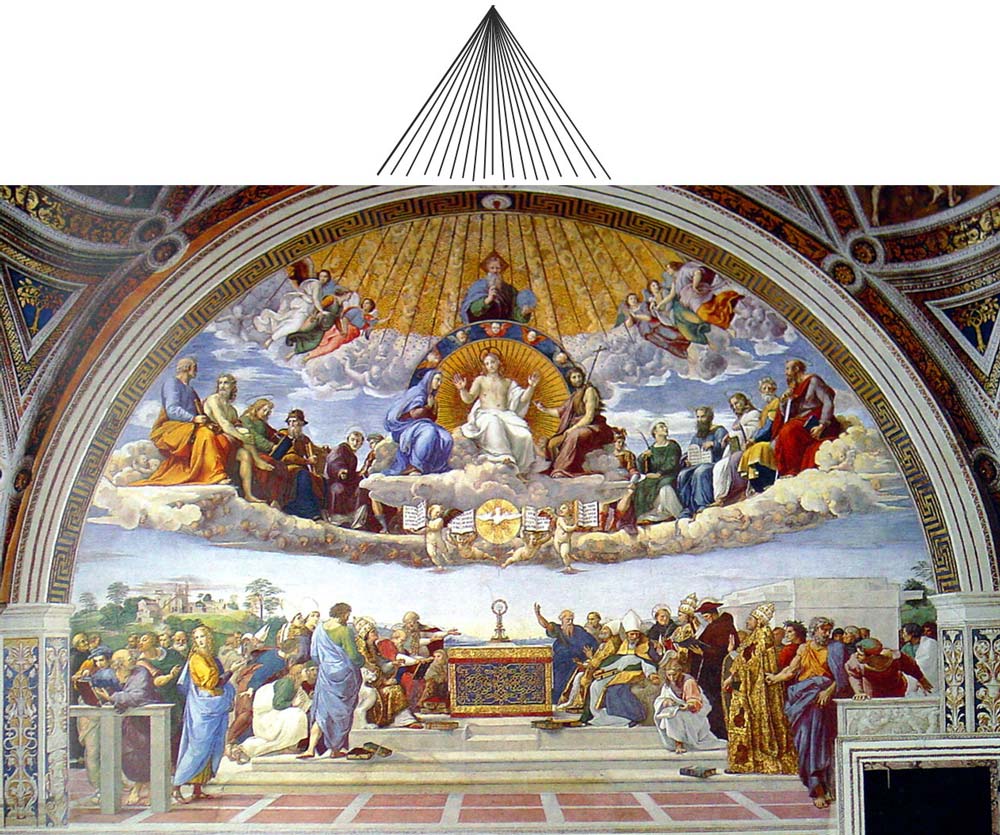
The imaginary point towards which those lines converge is the place where, in terms of composition, the fresco – especially the upper-middle part – finds a real synthesis or, if we want, its “vanishing point”. That point seems to support from above the whole complex structure below.
Descending along the central axis, we see the trinity (Father, Son and Holy Spirit) supported by that point without which the figure of God would lose tension and concentration; the circle of Christ and all the clouds with the saints and prophets would seem to be suspended in the air. It seems to me that this invisible point is fundamental to give meaning and life to the image.
Unity of human semblance and true unity
According to this interpretation, the fresco would show a unity of human semblance, which responded to the needs of the patrons of the fresco, but – at the same time – would indicate a supreme unity that the painter places outside the image as if he wanted to say that the true unity remains an elusive entity, invisible and, therefore, not representable.
It almost seems that the painter has tried modesty in facing an idea of totality that was all inside the image as it had made some years before his master Pietro Vannucci (Il Perugino) in the fresco L’Eterno con Profeti e Sibille realized for the Collegio del Cambio in Perugia:

Collegio del Cambio, Perugia
In La Disputa del Sacramento, that celebrates the certainties supported from the Church, it seems that Raffaello wanted to leave an open glimmer towards the imponderable.
Ahead of his time
I am not sure, however, that the painter has done it in a conscious way. I believe, rather, that he followed his eye and, usually, the eye of a great artist can go far beyond his conscious reasoning. I mean that to the painter’s eye that external point was indispensable in compositional terms to confer energy and unity to the whole. In the capacity of executor of the commission, Raffaello realized what was requested by the client and the latter was certainly satisfied but, as an artist, I believe that he intuited and expressed in his work more than what was requested of him.
Through form, an artist of the sixteenth century has expressed meanings that today we can understand as current while we can no longer identify with a manly figure of a bearded God placed above clouds in the sky nor with other common beliefs of that time. That outer point transmits energy and vitality to the whole image and is therefore closer to our idea of the divine today.
Mondrian wrote in 1920 that “the straight lines intersect and touch one another tangentially but continue uninterruptedly.” and as art historian Maurizio Calvesi points out: “the result radiates out from the painting to the infinite, but the canvas exhausts the intuition of the whole within itself.”
The lines act as a plastic symbol of eternal energy that flows and shapes all things. Neoplastic lines manifest themselves on the canvas generating harmonic relationships and then flow back into the real space of the world of which the canvas is a part; a part that hints at ideally represent the whole.
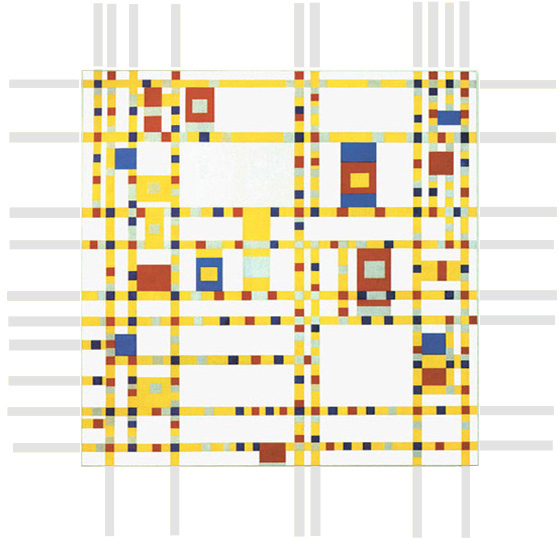
In Broadway Boogie Woogie we have seen the virtually infinite space of the perpendicular lines transformed into a finite plane that unites in itself the three primary colors, that is, the substance of the entire painting and of everything that, with the straight lines, ideally goes beyond the painting itself.
Yellow, the prevailing color of the lines, is what is most internalized within the unitary plane. It is a process of internalizing a physical space (the virtually infinite space of the lines) into a mental space (the finite, measured space of a plane). The unity of Broadway Boogie Woogie is therefore a plastic symbol of our idea of the presumed but unverifiable unity of the natural universe (to which the continuity of the lines alludes) which is unthinkable in its immeasurable extension.
After a progression from a multiplicity of small square to the unity of one large plane, Broadway Boogie Woogie shows the yellow-red-blue unity reopening to the multiplicity of the small squares and to the infinite space of the straight lines. In Broadway Boogie Woogie unity manifests itself and then flows back into the multiple to reformulate itself infinite times in the attempt to grasp a whole that will never be reached because it is infinite. It is a process that tends towards unity but never reaches it in a definitive form.
Objective and subjective unity
Broadway Boogie Woogie tells us of an objective unity, not representable in its totality, which becomes temporarily visible in the form of a plane synthesizing the three primary colors. The objective unity is suggested by the straight lines which, as we said, evoke the unreachable totality of the real physical world, while the mental and therefore finite translation of that infinite space is generated by the straight lines themselves which progressively merge together into small squares, symmetries and planes into one all-embracing plane:
This process is what Mondrian called “the subjectification of the objective.”
The invisible becomes visible
In Raffaello’s work, the objective unity (the external point) supports and gives life to the subjective unity (the God in human guise), just as in Broadway Boogie Woogie the straight lines (a symbol of infinite universal energy) give life to the visible unity within the painting.
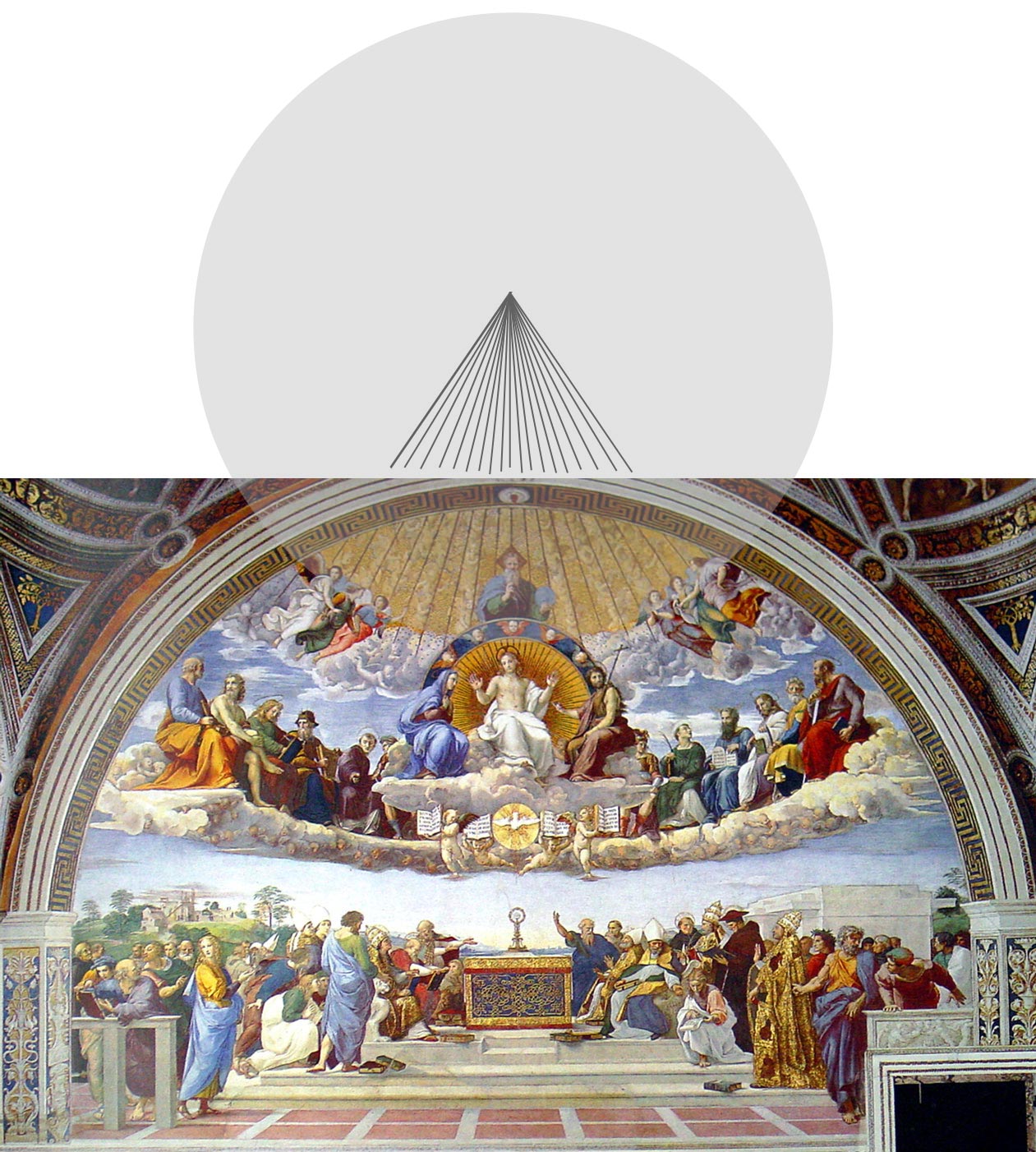
Both Raffaello and Mondrian therefore speak to us of an invisible unity and a visible unity. In the 16th century, the subjective representation of the objective is a bearded man holding a sphere in his hand. In the 20th century, the subjective representation of the objective is plane made of three primary colors.
In Broadway Boogie Woogie the objective remains as such (the endless continuity of the lines) but its subjective representation (the unitary plane) can change. Just think of how different cultures can work out different ideas of God, which should not necessarily mean that God loses its oneness.
The static rendering of a God in human likeness (La Disputa del Sacramento) becomes a dynamic idea of God (Broadway Boogie Woogie).
In my opinion, we are in front of two sacred images because both present an idea of synthesis and unity of all things and both ideas of unity seem plausible for the time in which they occur.
The idea of unity appears now in abstract form also because the modern image no longer presents only a small circle of human characters as we see in the ancient work, but opens itself ideally to all organic and inorganic forms of life even beyond our planet.
In Broadway Boogie Woogie every form is born, grows and develops as every natural form does from a flower on earth to a star in the universe. As in nature, nothing lasts forever; no entity is pre-established but becomes such in that particular situation, in that particular positional relationship with respect to the other forms undergoing reciprocal determination. A fluid space that gives concrete form to becoming more than being, to relations more than the individual things; a geometry that is anything but rigid, cold, or exclusively rational; a space that strikes me instead as very similar to life.
As Michel Seuphor wrote in his 1956 beautiful biography on the Dutch artist: “The development of Mondrian’s religious thought can therefore be summarized as follows: Calvinism is superseded by theosophy, which is itself absorbed (after 1916) by Neoplasticism called upon to express everything wordlessly.”
The universal becomes particular
In the work of the 16th century, objective unity (the point outside the painting) and subjective unity (the figure of God the Father) are fixed entities and remain separate and distinct:

In Broadway Boogie Woogie objective unity (the continuity of the straight lines) and subjective unity (the synthesis of yellow, red and blue) are inked together by a process that transforms one into the other (the straight lines that become the unitary plane and the unitary plane that then reopens to the straight lines):
In Broadway Boogie Woogie the absolute appears in a relative form; the eternal becomes everyday; the external becomes internal; the objective becomes for moment subjective and then all of this returns to the absolute, the eternal, the external, the objective. What Mondrian calls “true reality” (absolute, objective, eternal, invisible) becomes “our reality” (relative, subjective, everyday, visible) without ever detaching from “true reality”.
Equivalence of visible and invisible
In Broadway Boogie Woogie white, gray, yellow, red and blue constitutes a progressive transition from the lighter, ethereal and indistinct value (white) to the darker, solid and definite value (blue). Through the grayish little squares within the lines, yellow draws from white and then reaches, through red, the opposite value in blue. From the invisible (white) to the concrete and clearly visible (blue). The definite (yellow, red and blue) springs from the indistinct (white).
The synthesis of yellow, red and blue that evokes unity presents on the right an area of white color that has its own measurements and proportions. In that area, the “void” (white) is equivalent to the “full” (yellow, red, blue) and this contributes to a more balanced, stable and lasting fullness. This suggests equivalence between the visible and the invisible.
A spirituality of the future
Expressing themes of a spiritual nature through pure relationships of form and color means presenting them in a universal way that transcends the different languages and cultures for new human beings and citizens of the world. Here we have a possible spiritual path of modern thought, a sacred vision that is expressed in a precise language and is therefore no longer necessarily in conflict with science and modernity, a rational vision that is well aware of the imponderable aspects of life. This is of crucial importance for a spirituality of the future.
La Scuola di Atene and Broadway Boogie Woogie
The second fresco by Raffaello, La Scuola di Atene, is located on the wall opposite La Disputa del Sacramento and presents themes of philosophy, the sciences and the liberal arts. The painting depicts the most important philosophers of ancient Greece under the vaults of a building that seems to have been inspired by Donato Bramante’s plans for the new St. Peter’s Basilica in Roma:
Nature and architecture
In La Disputa del Sacramento the composition is divided between a real scene (at the bottom) and an imagined or metaphysical scene (in the middle-high part). In La Scuola di Atene the whole scene takes place, instead, entirely at the level of earthly life:
If in La Disputa, from the horizontal of the earthly scene one rises vertically towards the spiritual and the divine, in La Scuola everything is concentrated on the human and therefore remains at an horizontal earthly level.
In La Disputa we find ourselves in the open space of nature with the immensity of the sky above men:
In La Scuola everything takes place in an artificial space where nature (the sky) is enclosed and measured by architectural vaults, that is to say, by human’s mind.
Unity and duality
In La Disputa del Sacramento the earthly scene converges towards a vanishing point that corresponds to the monstrance placed on the altar while the metaphysical scene (clouds, saints and prophets) tends towards the unity of God and, higher up, towards a point that lies beyond the image:
The multiplicity presented in La Disputa del Sacramento tends towards unity.
Through the three architectural vaults of La Scuola di Atene, the gaze converges towards the figures of Plato (on the left) and Aristotle (on the right):
The composition therefore tends towards two points (the heads of the two philosophers). These are close but distinct and seem to compete for the vanishing point of the perspective construction of the whole composition.
This is not accidental because the theme of the fresco is philosophy and science, that is, rational thought that proceeds through antinomies that manifests duality.
We therefore see how the formal structure of the two frescoes already tells us what their contents are: the unity of faith in the first and the duality of thought in the second.
Aristotle and Plato are in the center because their vision of the world, rather than that of Heraclitus (seated below with his arm resting on a block of marble and portrayed in the guise of Michelangelo Buonarroti) inspired the thought of the time.
A synthesis of Platonism and Aristotelianism
Plato holds his hand up, with his finger pointing upward, indicating the world of ideas. The line extending from Plato’s finger follows the arch of the architectural vault and descends back to Aristotle’s hand holding a book, while with his other hand the philosopher points to the earthly world.
“Aristotle’s horizontal gesture, symbolizes the organization of the world through the Ethics, and Plato’s vertical gesture the movement of cosmological thought that rises from the sensible world to its ideal principle” (Chastel).
Plato’s finger that, following the curve of the architectural vault, descends in correspondence with Aristotle’s hand, suggests a synthesis of the two philosophies, which was probably the idea that the commissioners of the fresco wanted to illustrate. How to express a synthesis of Platonic and Aristotelian thought? In the two-dimensional space of the painting it can be done with a semicircle that ideally connects the two figures, i.e. Plato’s right hand and Aristotle’s left hand.
Plato’s gesture goes upwards, encloses the universe (the sky circumscribed by the architectural vault) and then descends to the ground, joining Aristotle’s hand. Using the semicircle that materializes in the architectural vault, the painter connects and unites the philosophy of Plato with the philosophy of Aristotle, thus expressing, in purely visual terms, the historical-literary content that the client required.
To read the arch as a line connecting Plato’s hand to Aristotle’s hand is, obviously, unrealistic from a three-dimensional point of view, since – in a real space – that arch would be well beyond the two philosopher bodies. However, in the art of painting the contents are expressed through the only two real and concrete dimensions of the pictorial surface.
Every good painter has always built up his images by establishing relationships that, first of all, interact on the two-dimensional plane even if they evoke the illusion of a three-dimensional space. The formal relations are born on the two-dimensional plane and, through a wise use of geometry and a conscious reading of the observer, they acquire meaning. I believe that in painting, and probably not only in painting, form precedes and determines content.
“Art is concerned with the how, not with the what… How it is done, that is the content of Art.” (Josef Albers, 1940)
Recap
As we have seen, in La Disputa del Sacramento, ascending from the bottom to the top, multiplicity (the crowd below) becomes unity (the figure of God) while, in the opposite direction, totality (evoked with the golden dome) descends on men through the human figure of God but, in this case, the symbol of unity does not reopen to the multiplicity of earthly characters but remains closed within itself with the monstrance placed on the altar.
On the wall depicting theology (La Disputa del Sacramento) we see a multiplicity evoking unity in the absolute terms of faith:
On the opposite wall, the composition which illustrates philosophy, the sciences and the liberal arts (La Scuola di Atene), we see a multiplicity tending toward a synthesis that remains open to duality because rational thought proceeds by contradictions:
In Broadway Boogie Woogie the duality expressed by horizontal lines opposed to vertical ones generates a multiplicity of small fragments that through a process of growth and progressive synthesis reach unity:
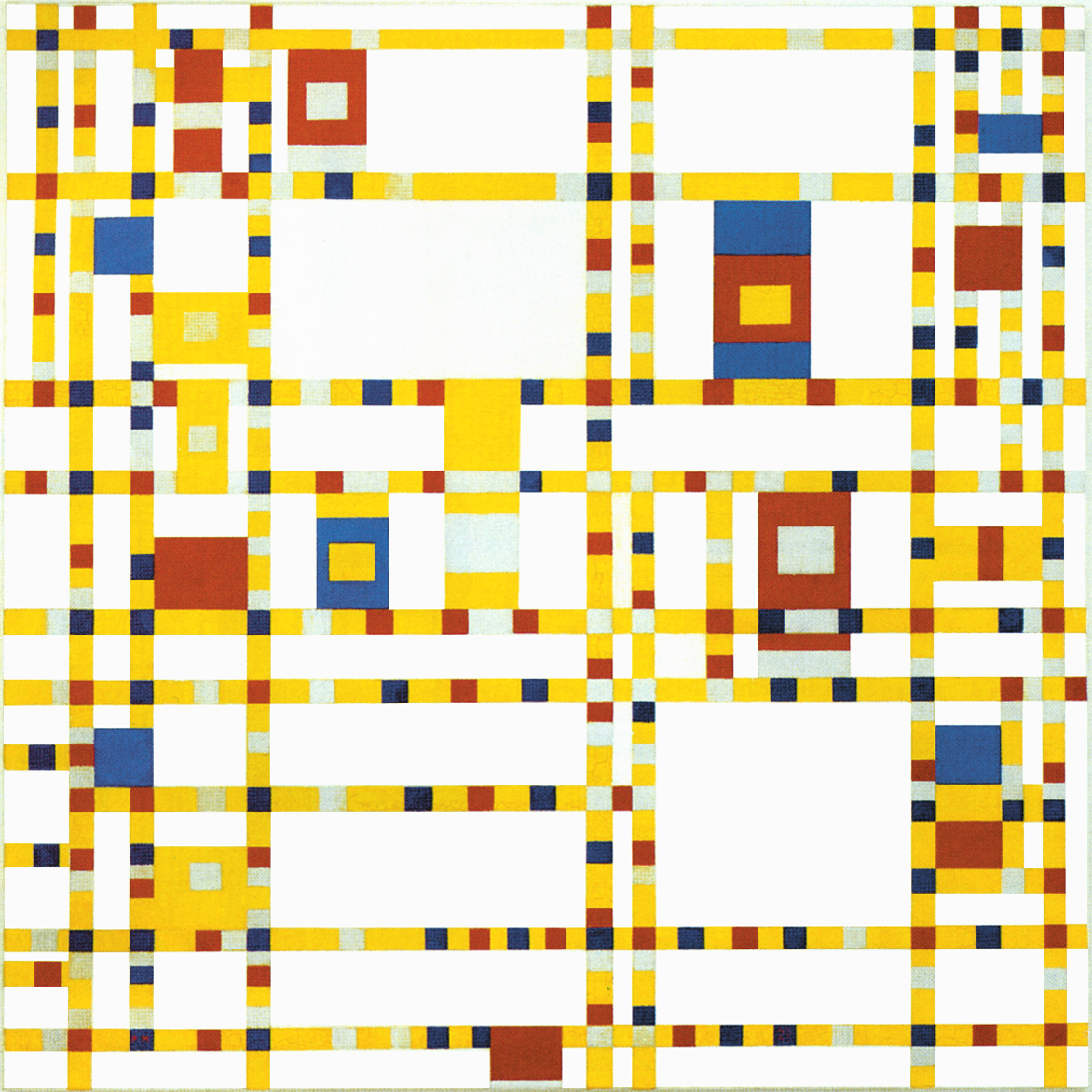
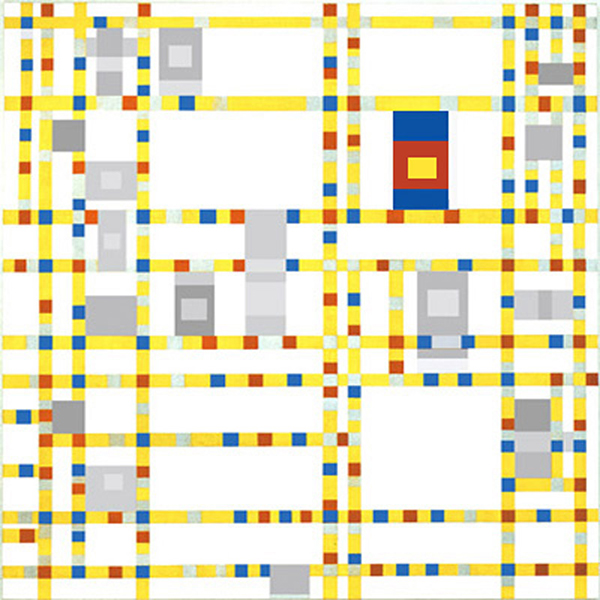
A unity that then reopens to new multiplicity and duality of opposite lines:

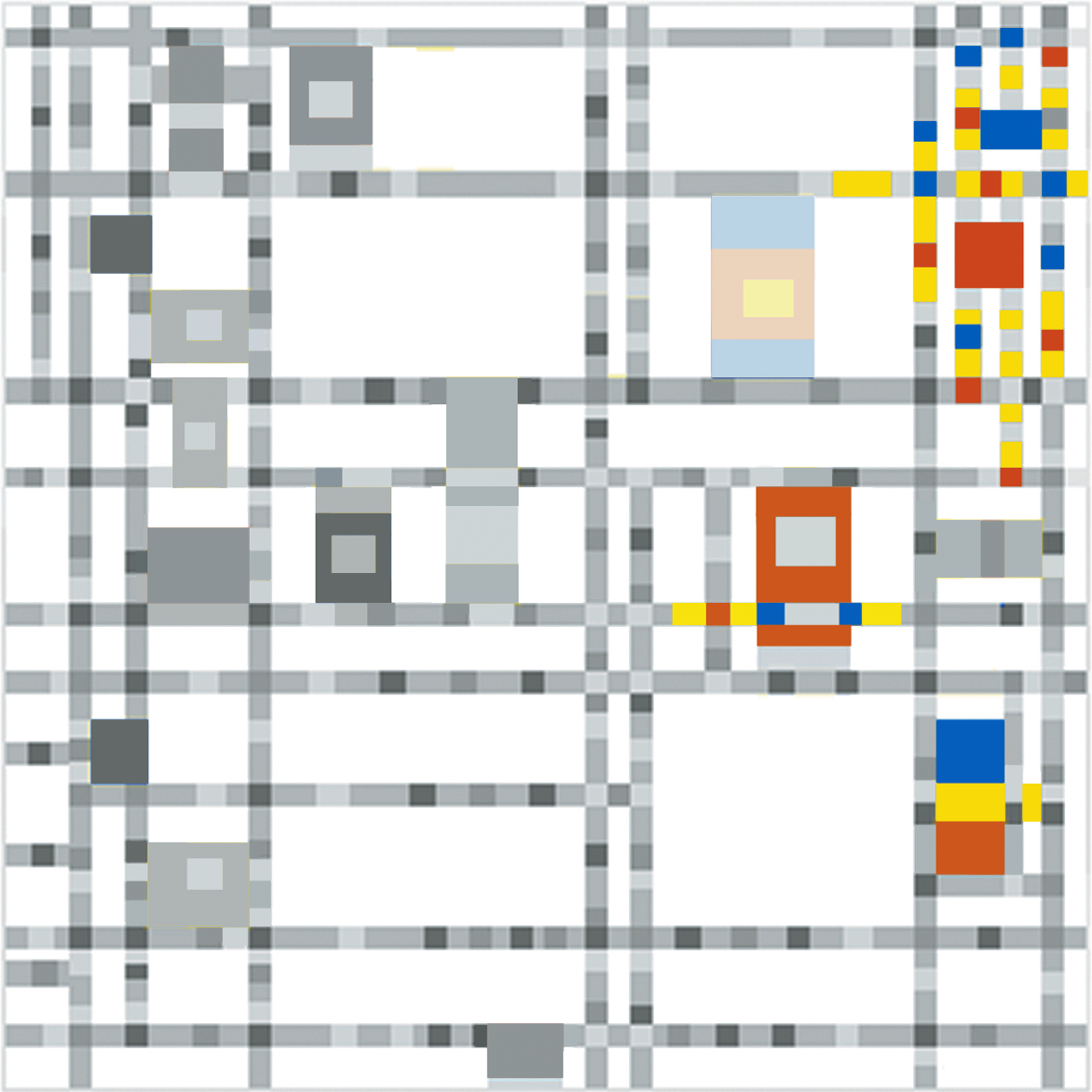
In this perspective we can say that the duality of rational thought (La Scuola di Atene) and the unity of theological and mystical thought (La Disputa del Sacramento) find an ideal synthesis in Broadway Boogie Woogie where the duality of opposite lines turns into a unity and this reopens to duality. The idea of unity reopens to the contradictory solicitations of reason and the real world avoiding to become clogged in preconceived and dogmatic formulas.
The 20th century painting can be considered, mutatis mutandis, an ideal synthesis of the 16th century frescoes.
Theology and science
Broadway Boogie Woogie exhorts to think of a theology that also satisfies rational instances and a science that does not lose sight of the spiritual.
“I believe that cosmic religious feeling is the strongest and noblest incitement to scientific research” (Albert Einstein).
Additional reflections on unity of all things
Additional reflections on the visible and the invisible
Copyright 1989 – 2025 Michael (Michele) Sciam All Rights Reserved More
